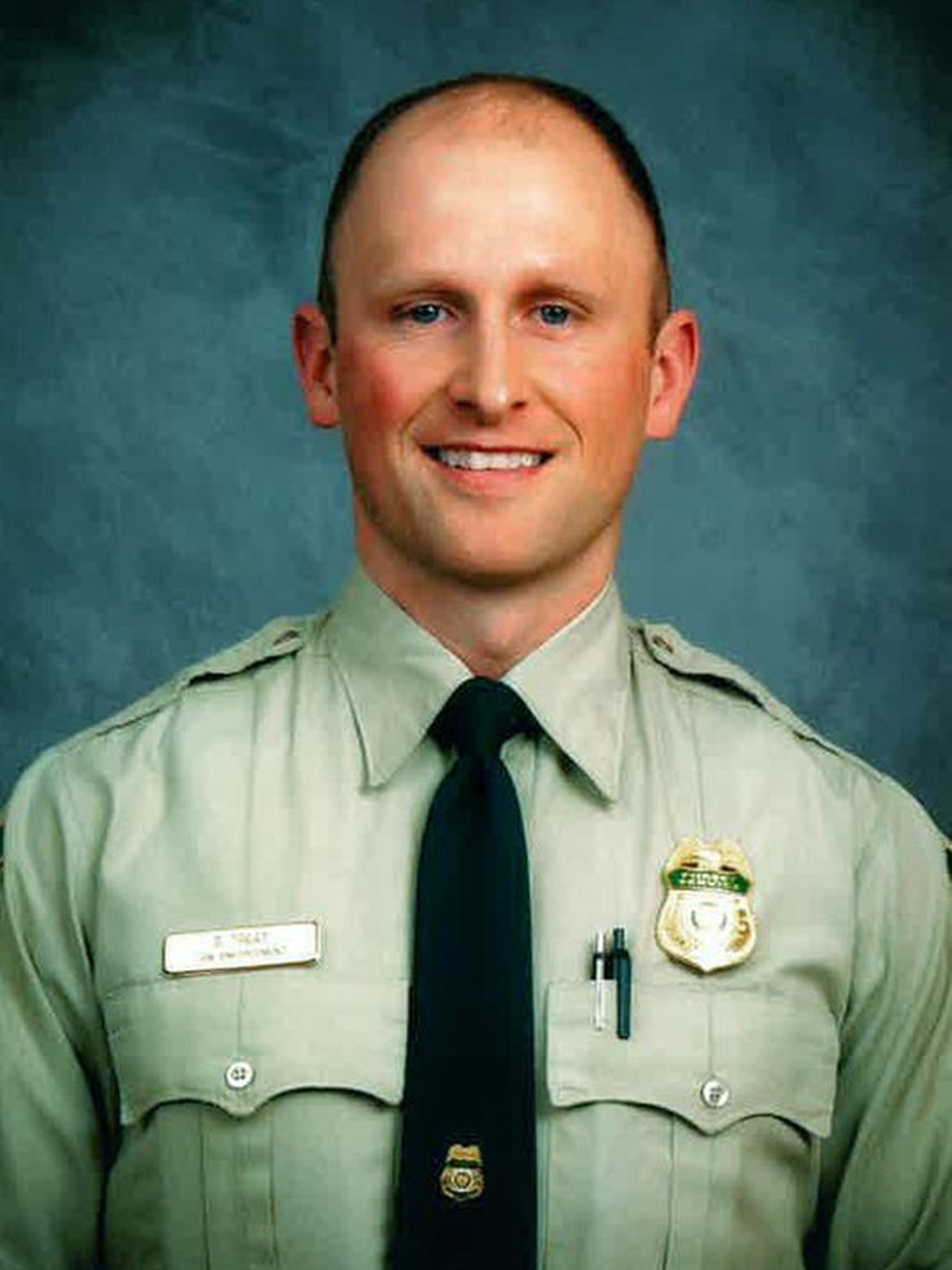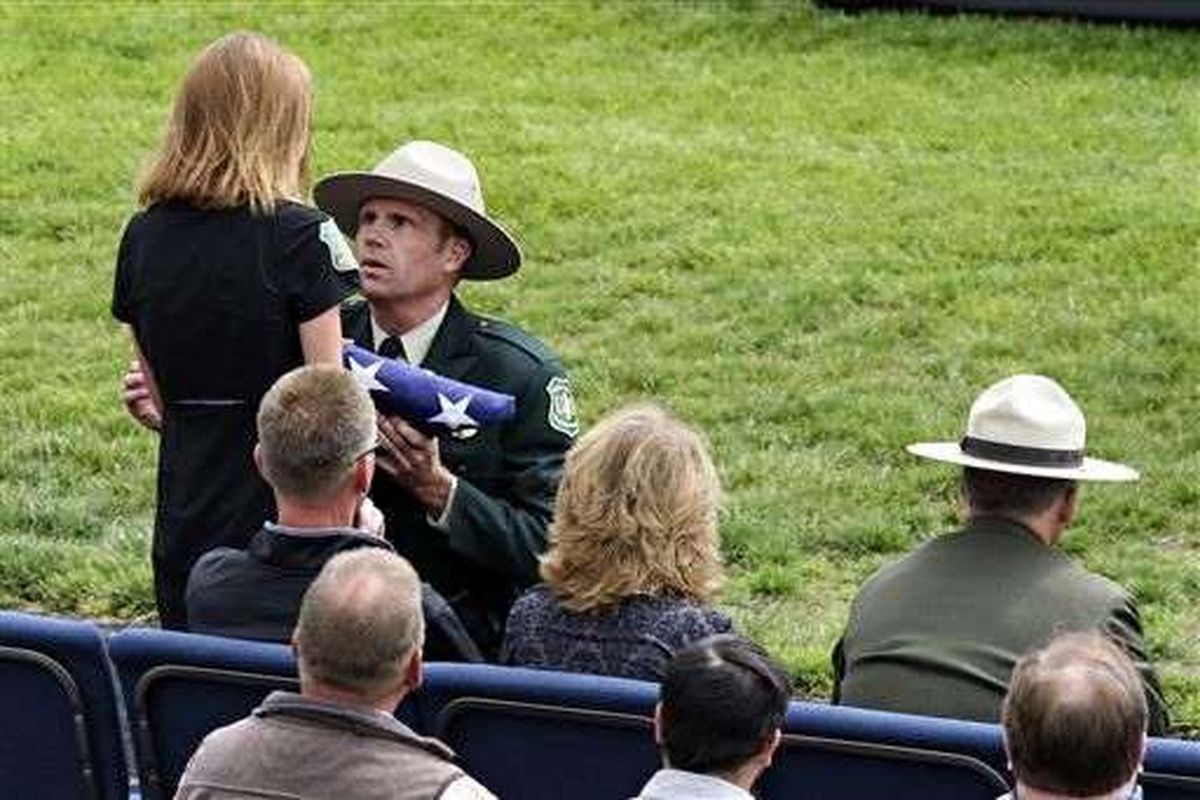Mauled mountain biker was riding fast before grizzly bear attack
This investigators photo show the trail mountain biker Brad Treat was riding before he was killed by a grizzly bear. The person on the trail indicates the collision-fatality site and is about 37 feet from the camera. At a speed of 20-25 mph, a biker would travel 29-36 feet a second, approximately the same distance from the camera to the person just visible on the trail. (From Board of Review report)
MOUNTAIN BIKING — The Kalispell mountain biker killed by a grizzly bear outside of Glacier National Park last year was going at a high rate of speed and couldn’t have avoided the surprise collision that triggered the mauling, investigators say in the official report released this week.
On June 29, 2016, Forest Service law enforcement officer Brad Treat was fatally mauled by a grizzly bear after accidentally surprising and colliding with the animal while mountain biking, the Board of Review Report has determined.
Following is a Great Falls Tribune story about the report and the board’s findings and further safety recommendations:
According to the report, Treat was mountain biking with a friend on the “Outer Trail” of the Green Gate Trails in the Flathead National Forest. Between 1:30 and 2 p.m., Treat collided with a grizzly bear with his bike at a high rate of speed after rounding a blind curve on the trail.
Treat had access to the trails system from his house and was reported to jog the trails with his wife almost every morning. Treat mountain biked on the trails four to six times a week. Treat’s wife, Somer, described him as competitive and said he often tried to beat his previous times as he traveled the route.
Treat was estimated to be traveling at about 20-25 miles per hour, giving him only 1-2 seconds after rounding the corner to see the bear. The investigation found no signs of skidding or evasive steering, indicating Treat did not immediately see the bear and hit him at full speed.
The collision hurtled Treat into and then over the handlebars of his bike and either onto or over the bear. The investigation indicated the impact caused Treat to break both of his wrists and his left scapula as he tried to break his fall with his hands.
The riding companion was reportedly 20 to 25 yards behind Treat when the incident occurred. The companion reported hearing the impact and heard the bear vocalize and make a sound “like it was hurt.”
The companion rode around the curve and saw the bear standing over Treat, who was laying on the trail. The bear was described as “very big, brownish-black in color, lighter than black” with its hair “bristled up.” The companion reported waiting about 30 seconds as he tried to figure out what to do. Neither Treat nor his companion had bear spray, firearms or cellphones with them.
The companion said the bear was “intent and focused on Mr. Treat,” and did not turn to look at the companion when he came into sight. The companion decided to turn around and head back up the trail the way they came to seek help because he did not feel comfortable trying to get the bear off of Treat.
When the companion heard vehicles on Highway 2, he began bushwhacking toward the road, carrying his bike. Highway 2 is approximately 1 mile away from the trail through thick forest.
The companion flagged down a vehicle and was driven to a phone to call for help. The call was received by 911 dispatch at 2:52 p.m.
The initial investigators found the victim and his bike in the trail at the collision site. Treat’s helmet was beside his body and was reported to be bitten to pieces by the bear.
According to the investigation, no part of the victim’s body was consumed by the bear and the bear did not cache the body by covering it with dirt and debris. Bears often cache items they intend to store and return to later.
Chris Servheen, board of review member and adjunct research associate professor at the University of Montana, said the evidence indicates this was not a predatory attack, but rather a surprise encounter.
Twelve hair and swab samples were obtained from the bicycle helmet and the victim. The hairs were tested for their genotype and found to belong to an 18- to 20-year-old male grizzly with no history of human-bear conflict. The bear had been captured once in May 2006 during a research project in Glacier National Park. At that time, the bear was estimated to weigh 370 pounds.
Though this is the first incident where someone in Montana has been killed by a bear while mountain biking, Servheen said instances of encounters with bears while biking is not unheard of.
“The main thing is to slow down in places with little sight distance, meaning you can’t see very far,” Servheen said. “When the trail is thick with vegetation or has curves, we recommend you slow down and shout when approaching blind curves. Speed and noise are the factors that get people when they’re out on their bikes. They’re moving faster and quieter.”
A 2000 study in Banff National Park in Alberta, Canada, found that though hikers greatly outnumber bikers on trails, the number of bear encounters for the bikers was disproportionately high. The study attributed the numbers to increased speed and stealth when traveling.
Following the investigation, the Board of Review members also released a set of recommendations related to mountain biker safety in bear country.
The recommendations include suggestions to stay vigilant, slow down, carry bear spray, make noise, don’t ride alone, never ride at dusk, dawn or night, don’t think “it won’t happen to me” and remember bears live there and you are just a visitor.
* This story was originally published as a post from the blog "Outdoors Blog." Read all stories from this blog


